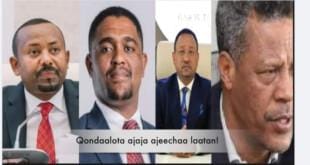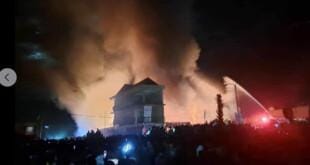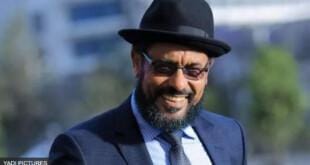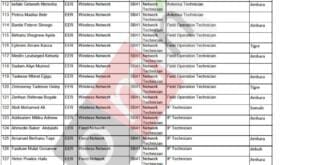Dureen akka Jaarraa biyya ormaatti boqochuun gadda kana dacha taasisa. Odoo takkaa hidhannoo hin hiikkatin fi kaayyoo bilisummaa Oromiyaa odoo hin faallessin boqochuun ammoo guddoo nama jajjabeessa.
Jaarraa wajjin walbaruun kiyya mana barnoota sadarkaa lammaffaa gaafan seene 1960-oota gara jalqabaa ti. Gaafas Abdulkarim (maqaa dhalootaa Jaarraa) fi waa’illi isaa Ahmed Yusuf dargaggoo fi ka’imman nanneen barnoota magaalaa Harar keessaa kakaasuu, politikaa barsiisuu fi jaaruuf tattaaffii godhan akka waan kaleessa taheettin yaadadha. Walgahii baay’ee irratti Jaarraan dhibdee bulchiinsi alagaa cunqursaan ummata Oromo irraan gahee fi seenaa boonsituu ummatichaa bareechee ibsee, bilisummaa, ulfinaa fi dagaagina Oromiyaa tiif hojjechuun dirqama dhaloota keenyaa tahuu hamilee dhaan ergaa dabarse fi dabarsiise takkaa hin irraanfanne.
Yeroon sun yeroo Baale keessa jeynootiin General Waaqoo Guutuu faa’iin durfaman diina falmaa turan. Jaarraan dhimma afaaniin haasawee, dargaggoo fi ka’imman barsiisa fi kakaasuutti ture san hojiin mirkaneessuuf, odoo hin turin qabsoowota Baalee lolaa turanitti dabalamee, dirqama ofii raaw’ate.
Sochii bilisummaa Oromo haarayatti ijaaaruuf Soomaliyatti carraaqii qabsaawotni godhanitti qooda mul’ataa warraa galmeessan keessaa Jaarraan sadarkaa tokkoffaa keessatti lakkaawama. Mootummaan Siyad Barree sochii Oromo sagantaa Somaliyaa Guddittii ittiin fiixa baasuuf murachuun gaafa barame, qabsawota walabummaa jaarmaya Oromo tiif cininnatanii falman, namoota akka Hussein Suraa faa wajjin, Yemen Kaabaatti bahanii jaaramuu dhaan, qabsoo hidhannoo qajeelchuuf qooda ol-aanaa gumaache. Murannoo hiriyaa hin qabneen, jeynoota qabsoo hidhannoo banuuf ifkennan hoogganuu dhaan daandii Oromiyatti deebiif filatetti gufuun qunnamtee (1969), waggaa shan caalaa gaarshiree (mana hadhaa) Siyaad Barree mudachuun beekkamaadha. (Baroota hidhaa san keessaa hanga tokkoof lolarratti wareegamuun isaa himamuus niin yaadadha.) Akka hojiin booda mirkanaawetti, hidhaan sun bilisummaa Oromiyaa tiif falmaa hidhannoo gochuuf murannoo isaa daran cimsite. Hidhaarraa gaafa hiikkame carraa dura argateen biyyatti deebi’ee, matootii sochii lafa-jalaa Baaro Tumsaa faa wajjin marihatee, tarkaanfiin fudhate kanuma raggaasisa.
Mootummaan Siyaad Barree baha Oromiyaa, kibbaa fi walakkaa qaama Somaliyaa Gudditti taasisuuf qophii gaafa raaw’atte (1975) Jaarraa hidhaa keessaa baaftee walgahii qopheessite takkatti afeerte. Walgahiin waltajjii marii haa jedhamtu malee akeekni dhugaa qabsoo Oromo hacuucuu fi ukkaamsuudha ture. Bara 1979 jilli Adda Bilisummaa Oromo (ABO) gaafa mariif Soomaliyaa ifaan dhaqe, qondaalota President Barree wajjin teessuma sanirra turan keessaa General Ismail Ahmed haala teessuma sanii, jila ABO mana ofiitti gaafa keesummeesse, bal’inaan waan ibse keessaahin qabxii takka akkanatti kaaya: “Abdulkarim hawwii President Barree odoo beekuu, sodaa malee isa dura dhaabbatee, ‘nuti duris qabsoo Oromootiif imaltoofne, arras hawwiin teenya isuma, biiroo faa nuu hayyamaa, nu gargaaraa’, jedheen”. General Ismail itti fufee: “Namoota keessan hedduu wajjin hojjadhe, Abdulkarim dhugaatti jeyna, ummataa isaa jaalata, kabaja. Yeroo wal-argitan kabajaan qabuuf fi salaamata kiyya itti himaa. Maqaa kiyya himaaf, na beekaa.”
Dhaamsa kana odoon ofirraa hin dabarsin boqochuun Jaarraa guddoo natti dhagayama. Ergaan isaa fi kaayyoon inni jireenya isa guutuu itti ciche ammoo arr’a sadarkaa guddoo waan geesseef, dhaloonni ammaa falmaa bilisummaa cimsee fuul-duratti tarkaanfachiisuun akka galiin gahu shakkii hin qabu. Qabsaawotaa fi maatiin haa jabaatan, innis nagayaan haa boqotu!
jaaraabbagadaaby Dr. Mohammed Hassen*
(OPride) — Abdulkarim Ibrahim Hamid, who is popularly known as Jarra Abba Gadaa, was a long-standing Oromo nationalist. His death a few days ago was a great loss for his family, for all those who knew him, for our people and for all freedom loving people everywhere. He was an exceptional person, who was driven with passion for freedom and human dignity of his people.
Jarra understood the connection between the conquest of the Oromo and the unmitigated attack on their cultural heritage. The purpose of that attack was to make the Oromo feel inferior in terms of their language, culture, history, way of life, political and cultural institutions. As a result of their conquest during and after 1880s the Oromo lost their sovereignty and freedom. With that they lost their land, their human dignity, as they were subjugated socially, dominated politically, exploited economically and dehumanized culturally. They also lost their pride as a people.
The daily degradation and oppression of the naftanya system took toll on the spirit of our people and slowly ate away at their national pride.Jarra Abba Gadaa was among few farsighted Oromo nationalists who had the wisdom to understand that a system that crushes the self-respect and self-confidence of individuals or a people, a system that kills the spirit of human dignity and pride is crude, brutal and oppressive that has to be resisted. For Jarra, there was nothing more precious than the human spirit of freedom, pride, self-respect and dignity of his people.
Through his lifelong struggle and sacrifice, Jarra Abba Gadaa and others were able to raise Oromo political consciousness that has altered how the Oromo perceive themselves and how they are perceived by others in the political landscape of Ethiopia and the Horn of Africa. It is the responsibility of the current Oromo generation to marshal their human, material, and spiritual resources to achieve their own liberation — the life-long objective for which Jarra struggled for more than half a century. When the history of Oromo struggle since the 1960s will be written, Jarra Abba Gadaa will have pride of place in that history. The purpose of this short piece is not to write about Jarra’s contribution to Oromo national struggle. It is only to mention few points that I remember about one of the most remarkable Oromo nationalists of our time.
Jarra Abba Gadaa and the formation the first Oromo student union
I first came to know Jarra Abba Gadaa in 1961 when I was a grade 6 student while he was 12-grade student in the city of Harar. At that time there were probably 3,000 students in the city of Harar, out of which there were no more than twenty to thirty Oromo students. During Christian and Muslim holidays in the city of Harar, Adare or Harari, Amhara, Tigrayan, and Somali students, all proudly sang their songs and danced their cultural dances and enjoyed their religious holidays. However, the few Oromo students were never able to enjoy their songs and cultural dances on their holidays. At that time, the Oromo were the most abused and humiliated people in Ethiopia. Some Oromo students hid their identity in order to escape from humiliation to which their people were subjected.
Jarra Abba Gadaa realized that people who lack self-respect lack the essential elements of humanity. After all, no one respects people who do not respect themselves and their cultural heritage. Jarra took the first important step on the long road to mental liberation of those who were touched by his magnetic personality. He contacted every Oromo student in Harar and brought us together in one place. That was how we were able to meet for the first time and came to know each other.
From the very beginning, all our meetings were conducted in Afan Oromo, which in itself was liberating experience as most of us who didn’t have a good command of Amharic language. Jarra informed us that he gathered us together to form the Union of Oromo students. He added that the purpose of Oromo student union was for organizing Oromo cultural show in the city of Harar. We were truly exhilarated.
In those days, the Oromo were called by the derogatory name of Gala. Although we never called ourselves by that name, we hated those who called us Gala. As a politically conscious young man, Jarra was far ahead of his time and suggested the name of our group to be the Union of Oromo students, which was unanimously endorsed by everyone at our first meeting. That was how the first Oromo student union in Ethiopia was born.
At that time most people in Ethiopia did not know that Oromo was the core of our people’s identity. It was Jarra’s political genius to pick our national name as the name of our student association. As the core of our people’s identity, our national name evoked an atmosphere of drama that captured our young minds with magic power that lifted us out of the depth of humiliation under which our people suffered for so long. Jarra was elected as the chairman of our union. Ahmed Mohammed Yusuf, who currently lives in Georgia, was elected as the secretary of our union. Taha Ali Abdi, who currently lives in London and one of the founders of the Oromo Liberation Front, and Jemal Ali Abdi, who currently lives in Toronto, were active members of our union.
Thanks to the leadership of Jarra Abba Gadaa, our union was able to organize the first ever Oromo cultural show at the cinema hall in the city of Harar in 1961. That in itself was a major achievement, when young students fearlessly and proudly performed Oromo cultural show in front of an audience, many of whom wept with joy and filled with pride that our language is as good as any other language in touching the human heart and soul. In those days, the Oromo language was proscribed in public. The exhilaration that we felt at that time is impossible to express in words today. Let me just say it was a wonderful experience that taught us the importance of having an organization. Even after Jarra Abba Gadaa and Ahmed Mohammed Yusuf graduated from Harar high school, our union was able to organize more Oromo cultural shows in the city of Harar. It only shows that organized individuals, no matter how small their number, can achieve tangible results.
My last encounter with Jarra before he joined the armed struggle
I saw Jarra Abba Gadaa for the last time before he embarked on nearly half a century of struggle, which defined his character and served as the life-spring of his existence. That was during the summer of 1966. We met in the city of Dire Dawa and went together to the house of my friend, where we had lunch and spent the whole afternoon talking about the conditions of Oromo at the time. Then Jarra was already a conscious nationalist who could no longer live in peace, while our people were subjected to daily humiliation in all ways, big and small. Although we did not realize it at that time, the idea of joining armed struggle was crystallizing in his mind. But he kept it to himself. Few months later we heard that Jarra Abba Gadaa joined the Bale Oromo armed struggle, which was led by General Waaqoo Guutuu.
The following section is based on the interviews I conducted with many individuals over the years, including, Sheikh Mohammed Rashad in Mogadishu, whom I interviewed on July 18, 1980, Adam Tukale Ali, popularly known as Mulis Abba Gadaa, whom I interviewed on June 17, 1982 in Jeddah, Saudi Arabia, and Abdullai Mumad Bili, popularly known as Abdullahi Lungo, whom I interviewed on June 20, 1982 also in Jeddah, Suadi Arabia.
According to the information I obtained from the above-mentioned individuals, it was during his participation in the armed struggle in Bale that Jarra first distinguished himself as a brave warrior. As an intelligent man, Jarra quickly realized the importance of obtaining modern military training. It was for that purpose that he went to Somalia in 1967 but quickly disappointed when he realized the Somali government of the time never wanted to support an independent Oromo force that they did not control.
Jarra then went to the Middle East where he worked with Elemo Qilxu, the famous Oromo nationalist leader. With support from the Iraqi government, Jarra and 38 of his comrades received a yearlong military training program and equipment for starting guerrilla activities. After completing their training, under the command of Jarra Abba Gadaa, the first small guerrilla group was dispatched to Hararghe . Unfortunately, Jarra and his comrades were ambushed by Somali forces while in transit through northern Somalia and were detained in November 1969 by the order of General Said Barre. They were detained without trial for five years and released only in 1975.
After his release, Jarra was taken to Mogadishu, where he was personally asked by General Said Barre to join the Western Somali Liberation Front (WSLF). Jarra refused joining the WSLF and secretly returned to Hararghe in early 1976. His return to Haraghe was a major turning point in modern Oromo history for several reasons that cannot be discussed in this short piece. Here it should suffice to say that Jarra Abba Gadaa established the first Oromo Liberation Army and started armed struggle, which for decades formed the central drama of his fascinating life of struggle. And that struggle was crucial for the rise of the Oromo national consciousness. Since the armed struggle conducted by the OLF faced bewildering vicissitude, I limit myself to mentioning only the following salient points as they are related to Jarra Abba Gadaa.
First, it was during his five-year detention that Jarra Abba Gadaa realized that the Government of General Said Barre had its own ambition for occupying extensive Oromo territories. It was such realization, which made Jarra a reflective and staunch Oromo nationalist. During the 1977-78 war between Ethiopia and Somalia, the WSLF and regular Somali forces occupied vast Oromo territories in Hararghe, Bale and Sidamo, and the Somali regime even attempted at transforming the Oromo into Somali speaking people through what the Somali regime called “crash program” of teaching Somali language to the Oromo people. That was the height of Somali ruling elites cultural chauvinism.
Jarra Abba Gadaa immediately understood that the struggle for the creation of Greater Somalia was a frontal attack on Oromo national identity. Jarra then mobilized the OLF forces under his command and resisted both the Somali aggression and Ethiopian military regime’s attempt at keeping the Oromo under century long domination. Consequently, the small OLF force, which may not have numbered more than 5, 000, were attacked by both Ethiopian and Somali forces. It was a miracle that the OLF force was able to survive the combined attack of the two major military forces in the Horn of Africa. It was even a bigger miracle that Jarra Abba Gadaa, who was targeted for killing by the security forces of both Ethiopia and Somalia, survived and outlived the regimes of Colonel Mengistu Haile Mariam and that of General Said Barre.
Second, Jarra Abba Gadaa left behind a legacy of half a century struggle, which will plant his name in the annals of the struggle for freedom and human dignity. His long struggle reflects and represents the spirit of Oromo determination to free themselves from a century long domination. A Tigrayan intellectual can no longer boldly claim that the Oromo “do not have a cultural substance on which to construct their nationalism” because they do not have heroes like Yohannes and Alula to look up to nor do they have a major insurrectionary history like the Weyane in their memory pool.”[1]
Oromo resistance was largely unnoticed by the outside world, but it provides them with heroes such as Jarra Abba Gadaa, who is at the center of the galaxy of our national heroes, including Mamo Mazamir, Elemo Qilxu, General Taddesse Birru, General Waaqoo Guutuu, Baro Tumsa, Rev. Gudina Tumsa, Shaykh Bakrii Saphalo, Magarsa Barii, Mulis Abba Gadaa, Sisai Ibssa, Adam Jiloo, and thousands of others.
Jarra Abba Gadaa became a legend in his own lifetime by registering half a century of struggle in the interest of his people. Heroes like Jarra Abba Gadaa and those mentioned aboveprovide the Oromo with rich store of memory pool as well as the substance with which to strengthen their nationalism. It is fitting to end this piece by stating that Jarra Abba Gadaa will be buried at the hallowed battlefield of Chalanqo (Calanqoo), where he will join thousands of Oromo, Adare/Harari and Somali warriors who died together on January 7, 1887, fighting against King Menelik of Shawa. Jarra Abba Gadaa’s burial place will soon become a new shrine for Oromo nationalists.
Finally, Jarra Abba Gadaa passed away physically. But he will live in the great heart of the Oromo nation. His spirit of unflinching resistance will live in the minds of our people. Heroes and legends do not die. They become the dynamic force of history, the source of inspiration for the living. May our Waaqaa rest his soul in peace and comfort us with better days for the Oromo and all the peoples of Ethiopia.
*The writer, Dr. Mohammed Hassen




